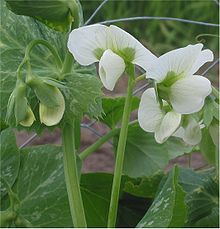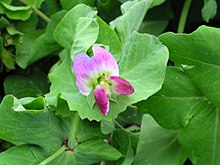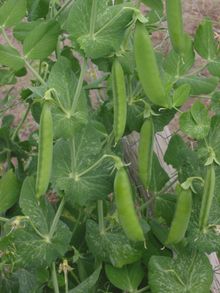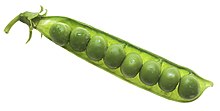pea
| pea | ||||||||||||
|---|---|---|---|---|---|---|---|---|---|---|---|---|

Pea ( Pisum sativum ), illustration |
||||||||||||
| Systematics | ||||||||||||
|
||||||||||||
| Scientific name | ||||||||||||
| Pisum sativum | ||||||||||||
| L. |
The pea ( Pisum sativum ), and garden pea or feed pea called, is a plant of the genus pea ( Pisum ) in the subfamily Schmetterlingsblütler (Faboideae) within the family of the Leguminosae (Fabaceae, Leguminosae). Originally from Asia Minor , the pea has been an important crop for thousands of years . It is high in protein and is used as a vegetable and animal feed .
description
Appearance and leaf
The pea is an annual , herbaceous plant . The root system is highly branched in the upper soil layer and can reach a depth of 1 meter in suitable soils . The prostrate or climbing stems are 0.5 to 2 meters long and are simple or branched at the base, hollow, angular, glabrous and bluish-green.
The leaves have one to three pairs of leaflets and branched leaf tendrils . The leaflets are ovate to broadly elliptical, rounded, with entire margins (or toothed at a distance). They are 2 to 7 inches long and 1.5 to 4 inches wide. The stipules are relatively large and wide half-heart-shaped with 4 to 10 centimeters. At the lower edge the stipules are toothed or bulged away and at the base they usually have a purple point. The stomata are on the top and bottom of the leaf blade.
Inflorescence and flower
One to three flowers are in a racemose inflorescence and the inflorescence axis often ends in an awn . The flower stalk is 5 to 10 millimeters long.
The hermaphrodite flowers are zygomorphic and five-fold with a double flower envelope . The five sepals are bell-shaped and sagged on the back. The calyx teeth are ovate-lanceolate. The lower calyx teeth are about three times as long as the calyx tube, and narrower and longer than the upper ones. The 15 to 36 millimeter long corolla has the typical structure of butterfly flowers . In the subspecies Pisum sativum subsp. sativum the flag is white, in the subspecies Pisum sativum subsp. elatius , the flag is pale purple and the wings are dark purple.
Fruit and seeds
The legumes are 3 to 12 centimeters long, 1 to 2.5 centimeters thick and, depending on the variety, green, yellow or brownish, rarely black. The legumes contain four to ten seeds , which, like the plant, are called peas.
The seeds have a diameter of 3 to 9 millimeters and are colored differently depending on the variety. The hilum is elliptical to circular with a diameter of about 2 millimeters.
Chromosome number
The number of chromosomes is 2n = 14.
Ecology and phenology
The root nodules are located on the lateral roots. The pea enters into a symbiosis specifically with the nitrogen-fixing nodule bacteria Rhizobium leguminosarum symbiovar viciae, which was first described in Pisum sativum and other butterflies by the Italian Malphigi in his work Anatome plantarum in 1675 . In addition, an arbuscular mycorrhiza with the fungus Glomus intraradices (now Rhizophagus intraradices ) and other types of fungus, which primarily improves the phosphorus supply, is important.
From an ecological point of view, it is “nectar-bearing butterfly flowers (= boat flowers)”. The pollination mechanism is a combination of a pump and a brush mechanism. The flowers smell of honey. The lower petals are so closely connected that only bumblebees can get the nectar , but even these rarely visit the flowers. In Central Europe, the pea is only visited by a few bees . We therefore mainly set the seeds through self-pollination of the cleistogamous flowers. At least in Central Europe, the pea is predominantly autogamous .
The flowering time extends from May to June, with a flower about three days and a specimen ten to 21 days.
The bloated legumes act as dehydration spreaders. There are typical rolled seeds with, in this case, a translucent seed coat, so that some features of the subsequent generation can already be recognized on the mother plant by the seeds.
Diseases
The pea is attacked by a variety of fungal pests. The rust fungi Uromyces viciae-fabae var. Viciae-fabae and Uromyces pisi occur on leaves. The powdery mildew Erysiphe pisi and the downy mildew Peronospora viciae also occur on leaves, as well as Alternaria alternata . Widespread fungi such as Fusarium oxysporum , Rhizoctonia solani , Sclerotinia sclerotiorum , Thielaviopsis basicola and Pythium spp. in front.
Chromosome set and mutants
Pisum sativum with the chromosome set 2n = 14 is a classic object of mutation research . Particularly noticeable are the double-pinnate mutants, in which all the leaflets are transformed into tendrils, so that, as with the vine pea Lathyrus aphaca , photosynthesis is almost exclusively carried out by the large stipules.
ingredients
Green, unripe peas contain 18 to 20% dry matter , which is distributed as follows: 5–8% protein , 0.5% fat , 10–15% carbohydrates . Ripe seeds contain 20–25% protein, 1–3% fat and 60% carbohydrates. Marquard gives the following percentages, based on dry weight : 25.7% raw protein , 1.4% raw fat , 53.7% carbohydrates, 18.7% dietary fiber and 2.9% minerals .
The amino acids essential for humans are present in peas as follows (in grams per 16 grams of nitrogen): ( cysteine 1.0), methionine 0.9, lysine 7.3, isoleucine 4.2, leucine 7.0, phenylalanine 4 , 4, ( tyrosine 3.1), threonine 3.8, tryptophan 1.5, valine 4.7.
The average mineral content is:
- Macro-elements (as a percentage of dry matter): calcium 0.06, phosphorus 0.42, sodium 0.03, potassium 1.06, magnesium 0.13.
- Microelements (in mg per kg): iron 56, zinc 39, manganese 14, copper 8.
Dry peas have a tannin content of 0.9 to 1.4%, the tannin content of field peas is between 1.5 and 2.5%.
Peas, like most legumes , contain phytoestrogens that reduce the fertility of mammals. In India, women used pea pod soup to delay conception.
Pea seeds also contain a small amount of cyanogenic glycosides ( linamarine ), around 2.3 mg HCN per 100 g.
Systematics
The first publication on Pisum sativum was in 1753 by Carl von Linné in Species Plantarum , 2, p. 727.
Within the broad type Pisum sativum a diversified swarm unclear definable forms, cultivars and land races by various authors as more than 100 subspecies or varieties exist described have been. According to genetic analyzes, these are strongly characterized by hybridization and introgression . These include the presumed wild stem form of the cultivated pea, mostly as a subspecies Pisum sativum subsp. elatius . The wild-growing clans have a large area that stretches from southern Mediterranean Europe and North Africa, west to Spain, across Middle and Central Asia and Iran to Turkmenistan. The genetic analyzes confirm an origin of the culture form in the " Fertile Crescent " in West Asia. As expected, the genetic variability of the wild form is considerably higher than that of the cultivated form, and includes this. Many authors also recognize a second wild subspecies, the Pisum sativum subsp. syriacum or Pisum sativum subsp. called pumilio ; this is more widespread to the east and occurs eastward from central Anatolia. Its genetic basis is unclear; it is also linked to elatius through a broad swarm of mixed forms .
The subspecies Pisum sativum subsp. sativum
Today the pea is grown all over the world. Very many varieties and convarieties have been described. The most important are:
- Field pea ( Pisum sativum L. convar. Speciosum (Dierb.) Alef. , Often as arvense Pisum or Pisum sativum subsp. Arvense performed), even pea , green pea , field pea or Peluschke called, is grown as grain feed. The crushed seeds are used as concentrated feed for dairy cattle and poultry. Field peas are also grown as green fodder and green manure. In terms of soil and climate, they are less demanding than the other varieties. They used to be added to bread flour as flour.
- Smooth peas ( Pisum sativum L. convar. Sativum ), also Pahl , scarf or Kneifelerbsen called, have smooth-skinned seeds. Their dry grain is mostly used for cooking (dry peas). For other uses, they must be harvested young, because when the kernels have grown too large they have a slightly floury taste.
- Field peas ( Pisum sativum L. convar. Medullare Alef. ) Have a shriveled grain when ripe, contain sugar (6-9%, almost exclusively sucrose ) and therefore taste sweet, which is why they are often mistakenly regarded as sugar peas. They are mostly used for preservation (for wet canning light varieties are preferred) and freezing (more darker varieties). As dried peas, they are unsuitable for cooking because they do not become soft when cooked. In the meantime, there are also smooth-grain peas, so that they are very difficult to distinguish from the peas.
- Peas ( Pisum sativum L. convar. Axiphium Alef. ), Also peas , Kiefelerbsen or Kefen called no parchment layer have in the sleeve and are not tough. Mainly whole meaty, sweet and thick pods with undeveloped grains are consumed. Most varieties have pea kernels, only some pea kernels. They are the most popular among the classes of peas.
Cultivation
The area under cultivation for dry peas in Germany was 85,500 hectares in 2017, with a focus on eastern Germany. Cultivation has declined in the last two decades (still 139,000 hectares in 2001, 85,500 in 2016), particularly for fodder peas for cattle breeding.

The culture form is widespread today in temperate areas worldwide, up to 67 ° north latitude, for example in Scandinavia. In the Alps it grows up to altitudes of 2000 meters.
The pea grows best on clay soils with sufficient humus and lime, balanced water flow and good ventilation, such as loess and deep limestone soils . The soil reaction should be in the neutral to weakly basic range, approximately between pH 6 and 7. Heavy clay soils, sandy and bog soils are not suitable. The pea has a strong intolerance to itself, so cultivation breaks of six to eight years must be observed. Due to the early harvest date and the positive influence on the soil structure, it is considered a good previous crop for rapeseed and winter cereals. In Central Europe, peas are sown in spring, from March to early April, using drill seeding. Mixed cultivation with broad beans or grain also occurs. As a nitrogen-fixing legume , little or no nitrogen fertilization is necessary. Peas are quite sensitive to weeds , so herbicides are mostly used.
The pea beetle , the pea moth and the pea aphid have specialized in peas and pea plants as a food source . The problem is often sitona (genus Sitona ).
Economical meaning
- The largest pea producers in the world
In 2017, according to the Food and Agriculture Organization FAO, around 20.7 million tons of green peas and 16.2 million tons of dry peas were harvested worldwide.
The following tables provide an overview of the 10 largest producers of green and dry peas worldwide.
|
|
In 2017, the harvest volumes for dry peas in Germany were 298,100 t, in Austria 15,259 t and in Switzerland 14,361 t.
use
Most of the dry peas are fed as pea meal in animal nutrition , as well as pea feed meal from food production and pea bran as residue in the husking mill . Pea straw is also fed because of its high nutrient content. The pea is used as green fodder and fertilizer .
Dry peas, which were mainly prepared as puree, were originally used for human consumption . Pea soup is still popular today . The pea sausage originated in the 19th century . Dried peas are used as whole peas (with the seed shell) or as half peas (with the seed shell removed). Today, peas are mainly prepared green in Central Europe. Peas are often used in canned and frozen form; seldom fresh, as peas do not keep very long and lose their taste quickly. Unlike in the past, it is used as a vegetable side dish, less as a staple food.
According to research by Urbano 2005, sprouted peas could make the nutrients more digestible.
Cultures of the pea are used as renewable raw materials for the production of starch , e.g. B. for the production of biodegradable films.
history
From around 8000 BC The cultivation of peas is documented by archaeological finds, making it one of the oldest cultivated plants. In many of the oldest finds, however, it is sometimes difficult to distinguish between cultivated and wild-collected peas; the most important characteristic, the structure of the seed coat, has mostly not been preserved. Finds are from numerous settlements of the pre-ceramic Neolithic from the fertile crescent of the Near East. The oldest finds so far come from Aswad in Syria and are around 10,500 to 10,200 years old, finds from Çayönü in Anatolia and Jericho in the Jordan Valley are only slightly younger. Already from approx. 7,000 BC. There are also finds from excavations in Cyprus and the Aegean region. Finds from Nea Nicomedeia are around 8,400 to 8,200 years old. In Bulgaria , too , the culture is almost as old.
In Germany, the pea (from Middle High German areweiz , also erbeiz ), like the lentil , was the staple food of the oldest arable farmers, the band ceramists , along with grain . Peas are also found at every second grain site, the northern border was the northern edge of the low mountain range. From the Middle Neolithic there are proportionally much fewer pea finds, the cause for this is unclear, but it may have been due to increased livestock farming. In the Bronze Age, from around 1800 BC. BC, the proportion of legumes and thus also of peas increased again.
In ancient times, the pea was also widely grown in Europe. The ancient Greek and Roman authors mention them only rarely and in passing. Also in Capitulare de villis Charlemagne peas are mentioned ( pisos mauriscos ). In the 13th century, Petrus de Crescentia from Bologna mentioned white-seeded peas. In the herbal books of the 16th century, a distinction is made between small field peas with white flowers and large garden peas with pink or red flowers. B. with Leonhart Fuchs . There does not seem to be a tradition as a medicinal plant; Madaus' otherwise comprehensive textbook on biological medicinal products does not even mention the pea.
Until the 17th century, the pea was used as a dried vegetable and generally eaten as a sauce. It was not until the 16th or 17th century that varieties were bred that were eaten unripe and green or as sugar peas with the pod. In the beginning these peas were very expensive and very popular at the court of King Louis XIV. However, the dry peas were only replaced by modern preservation techniques (canning, deep-freezing) from the menu. You are experiencing a small renaissance with the whole food kitchen.
Customs and culture
On the one hand, peas were considered food for the dead . Anyone who ate peas during Holy Week should soon have a corpse in the house. Eating peas during the twelve “ Rauhnächte” should also lead to various accidents. In Bohemia it was custom to sprinkle pea puree crosswise in the corners of the rooms on Christmas Eve, probably a relic from the worship of the dead spirits , later it was said “for the mice”. In some areas, pea soup is an integral part of the funeral feast , for example in Mecklenburg . In Freiburg im Breisgau it was served at the wake .
Peas were also considered to bring fertility, since the deceased ancestors also brought fertility . Some customs in this context were / are: peas as first feed for the pigs on New Year's Eve (East Prussia); Pounding a sack of peas on fruit trees so that they bear as much fruit as peas in a sack; Peas as wedding food; Peas to throw at the newlyweds. The pea bear , which occurs in the Rhineland Carnival or in the Alemannic region , or was part of the bridal procession in East Germany until the 20th century, should also be mentioned as a fertility bringer. In Germanic times, the pea bear was an embodiment of the thunderstorm god Thor (Donar), hence the custom in some areas of Germany to eat pea soup on Thursdays (e.g. Swabia).
There is no mention of peas in the Bible . In fairy tales they are mundane food, e.g. B. Basile's The Flea , The Dummling , The Golden Trunk , in the famous Cinderella and in The young giant from Grimm's fairy tale . In The Twelve Hunters , The Robber Groom , The Blue Light , scattered peas are supposed to discover the bridegroom or culprit. In Hans Christian Andersen's The Princess and the Pea , noble origins are tested, while five from a pod shows existential need, as does Bechstein's legend No. 715 The Pea Field . Pea puree was considered the favorite dish of dwarfs and brownies , cf. Grimms legend No. 156 blacksmith Riechert .
literature
- Runchun Jing, Alexander Vershinin, Jacek Grzebyta, Paul Shaw, Petr Smýkal, David Marshall, Michael J. Ambrose, TH Noel Ellis, Andrew J. Flavell: The genetic diversity and evolution of field pea (Pisum) studied by high throughput retrotransposon based insertion polymorphism (RBIP) marker analysis. In: BMC Evolutionary Biology. No. 10, 2010, p. 44. doi: 10.1186 / 1471-2148-10-44
- Siegmund Seybold (Ed.): Schmeil-Fitschen interactive. CD-ROM. Quelle & Meyer, Wiebelsheim 2001/2002, ISBN 3-494-01327-6 .
- Wolf Dieter Storl, Paul Silas Pfyl: known and unknown vegetables. Piper, Munich 2006, ISBN 3-492-24727-X , pp. 49-57.
Web links
- Detailed culture instructions from gemüse-info.de
- Udo Pollmer : In the pea madness . Justus von Liebig's questionable nutrition experiment, Deutschlandradio Kultur, October 26, 2013, accessed on February 7, 2015.
- Pisum sativum L., garden pea. In: FloraWeb.de.
- Distribution map for Germany. In: Floraweb .
- Pisum sativum L. s. st. In: Info Flora , the national data and information center for Swiss flora . Retrieved November 27, 2015.
- Thomas Meyer: Data sheet with identification key and photos at Flora-de: Flora von Deutschland (old name of the website: Flowers in Swabia )
- Günther Blaich: data sheet with photos.
- Gerhard Nitter: Profile with photos.
- Walter H. Schuster, Joachim Alkämper, Richard Marquard, Adolf Stählin: Legumes for grain use: Grain legumes of the world. Justus Liebig University, Giessen 1998. Walter H. Schuster: Information on pea (Pisum sativum L.) .
Individual evidence
- ↑ a b c d e f g Ruprecht Düll , Herfried Kutzelnigg : Pocket dictionary of plants in Germany and neighboring countries. The most common Central European species in portrait. 7th, corrected and enlarged edition. Quelle & Meyer, Wiebelsheim 2011, ISBN 978-3-494-01424-1 .
- ^ Erich Oberdorfer : Plant-sociological excursion flora for Germany and neighboring areas. 8th edition. Verlag Eugen Ulmer, Stuttgart 2001, ISBN 3-8001-3131-5 , pp. 620-621.
- ↑ Marco A. Rogel, Ernesto Orme'no-Orrillo, Esperanza Martinez Romero: Symbiovars in rhizobia reflect bacterial adaptation to legumes. In: Systematic and Applied Microbiology. Volume 34, 2011, pp. 96-104. doi: 10.1016 / j.syapm.2010.11.015 .
- ^ TJ Daniell, R. Husband, AH Fitter, JPW Young: Molecular diversity of arbuscular mycorrhizal fungi colonizing arable crops. In: FEMS Microbiology Ecology. Volume 36, 2001, pp. 203-209. doi: 10.1111 / j.1574-6941.2001.tb00841.x
- ↑ Peter Zwetko: The rust mushrooms Austria. Supplement and host-parasite directory to the 2nd edition of the Catalogus Florae Austriae, III. Part, Book 1, Uredinales. (PDF; 1.8 MB).
- ↑ Friedemann Klenke, Markus Scholler: Plant Parasitic Small Mushrooms: Identification book for fire, rust, powdery mildew, flagellate mushrooms and usury relatives in Germany, Austria, Switzerland and South Tyrol . Springer-Verlag, 2015, ISBN 978-3-662-46162-4 , pp. 966 ( accessed from Google Books ).
- ↑ Soner Soylu, Sibel Dervis: Determination of Fungal Diseases of Pea (Pisum sativum L.) Plants Growing In Amık Plain. Res. On Crops 12 (2): 588-592 (2011). Available online via ResearchGate
- ^ A b Walter H. Schuster, Joachim Alkämper, Richard Marquard, Adolf Stählin: Legumes for grain use: Grain legumes of the world. Justus Liebig University, Giessen 1998: Walter H. Schuster: Information on pea (Pisum sativum L.) .
- ↑ a b c d e Walter H. Schuster, Joachim Alkämper, Richard Marquard, Adolf Stählin: Legumes for grain use: Grain legumes of the world. Justus Liebig University Giessen, 1998: Richard Marquard: Nutritive and anti-nutritional ingredients in legumes.
- ^ SN Sanyal: Observations on oral contraceptives from Pisum sativum Linn. In: Bulletin of the Calcutta School of Tropical Medicine. Volume 10, 1962, pp. 85-89 ( ISSN 0068-5372 ) PMID 13976436 , see also Time. March 5, 1956 ( Medicine: For Teeming India ).
- ↑ Storl, Pfyl 2006, p. 56.
- ↑ a b pea at Tropicos.org. Missouri Botanical Garden, St. Louis, accessed February 2, 2015.
- ↑ Petr Smýkal, Gregory Kenicer, Andrew J. Flavell, Jukka Corander, Oleg Kosterin, Robert J. Redden, Rebecca Ford, Clarice J. Coyne, Nigel Maxted, Mike J. Ambrose, TH Noel Ellis: Phylogeny, phylogeography and genetic diversity of the Pisum genus. In: Plant Genetic Resources: Characterization and Utilization. Volume 9, Issue 1, 2011, pp. 4-18. doi: 10.1017 / S147926211000033X .
- ↑ Pisum sativum subsp. syriacum in Mansfeld's World of Agricultural an Horticultural Crops. accessed on February 2, 2015.
- ↑ Pisum sativum subsp. sativum at Mansfeld's World Database of Agricultural and Horticultural Crops .
- ↑ Data sheet at International Legume Database Information Service = ILDIS - LegumeWeb - World Database of Legumes , Version 10.38 from July 20, 2010.
- ↑ Duden online: Peluschke
- ↑ a b c Crops> Peas, dry and Peas, green. In: Official FAO production statistics for 2017. fao.org, accessed on April 12, 2019 .
- ^ Horst Mielke, Bärbel Schöber-Butin: Cultivation and plant protection of renewable raw materials (special crops). Protein, oil, dye, inulin and fiber plants. In: Messages from the Federal Biological Research Center for Agriculture and Forestry Berlin-Dahlem. Issue 395, Berlin 2004, ISBN 3-930037-11-4 .
- ↑ Bayerische Landesanstalt für Landwirtschaft (LfL) (Ed.): Large-grain legumes. Diseases and pests. Leaflet. ( Download )
- ^ A b Maguelonne Toussaint-Samat: A History of Food. 2nd Edition. John Wiley & Sons, 2009, ISBN 978-1-4443-0514-2 .
- ↑ Glorai Urbano, María López-Jurado, Sławomir Frejnagel, Elena Gómez-Villalva, Jesús M. Porres, Juana Frías, Concepción Vidal-Valverde, Pilar Aranda: Nutritional assessment of raw and germinated pea (Pisum sativum L.) and carbohydrate by protein in vitro and in vivo techniques. In: Nutrition. Volume 21, 2005, pp. 230-239. doi: 10.1016 / j.nut.2004.04.025 PMID 15723753
- ↑ Wulf Diepenbrock: Renewable raw materials. UTB, 2014, ISBN 978-3-8252-4189-6 .
- ^ Pea (Pisum sativum). In: Daniel Zohary, Maria Hopf, Ehud Weiss: Domestication of Plants in the Old World: The Origin and Spread of Domesticated Plants in Southwest Asia, Europe, and the Mediterranean Basin. Oxford University Press, 2012, ISBN 978-0-19-954906-1 , pp. 82-87.
- ↑ Udelgard Körber-Grohne : Useful plants in Germany from prehistory to today . Theiss, Stuttgart 1995, ISBN 3-8062-1116-7 , pp. 131-139.
- ↑ Kimberly B. Flint-Hamilton: Legumes in Ancient Greece and Rome: Food, Medicine, or Poison? In: Hesperia. The Journal of the American School of Classical Studies at Athens. Volume 68, No. 3, 1999, pp. 371-385.
- ^ Leonhart Fuchs: New Kreüterbuch. Caput CCXL, 1543 (Reprint: ISBN 3-8228-1298-6 ).
- ^ Entries "Erbse", "Erbsenbär" In: Eduard Hoffmann-Krayer, Hanns Bächtold-Stäubli: Concise dictionary for German folklore. Department 1: Superstition. Volume 2: C to women wear. Walter de Gruyter, Berlin / Leipzig, 1929/1930. (Reprint: 2010, ISBN 978-3-11-085537-1 )









